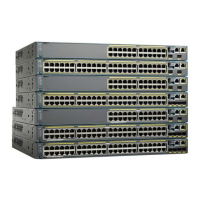Related Topics
EtherChannel Configuration Guidelines, on page 338
Default EtherChannel Configuration, on page 337
Layer 2 EtherChannel Configuration Guidelines, on page 340
Monitoring EtherChannel, PAgP, and LACP Status, on page 358
Configuring the LACP Port Priority
By default, all ports use the same port priority. If the local system has a lower value for the system priority
and the system ID than the remote system, you can affect which of the hot-standby links become active first
by changing the port priority of LACP EtherChannel ports to a lower value than the default. The hot-standby
ports that have lower port numbers become active in the channel first. You can use the show etherchannel
summary privileged EXEC command to see which ports are in the hot-standby mode (denoted with an H
port-state flag).
If LACP is not able to aggregate all the ports that are compatible (for example, the remote system might
have more restrictive hardware limitations), all the ports that cannot be actively included in the EtherChannel
are put in the hot-standby state and are used only if one of the channeled ports fails.
Note
Follow these steps to configure the LACP port priority. This procedure is optional.
SUMMARY STEPS
1.
enable
2.
configure terminal
3.
interface interface-id
4.
lacp port-priority priority
5.
end
DETAILED STEPS
PurposeCommand or Action
Enables privileged EXEC mode. Enter your password if
prompted.
enable
Example:
Switch> enable
Step 1
Enters global configuration mode.configure terminal
Example:
Switch# configure terminal
Step 2
Consolidated Platform Configuration Guide, Cisco IOS Release 15.2(4)E (Catalyst 2960-X Switches)
351
How to Configure EtherChannels
